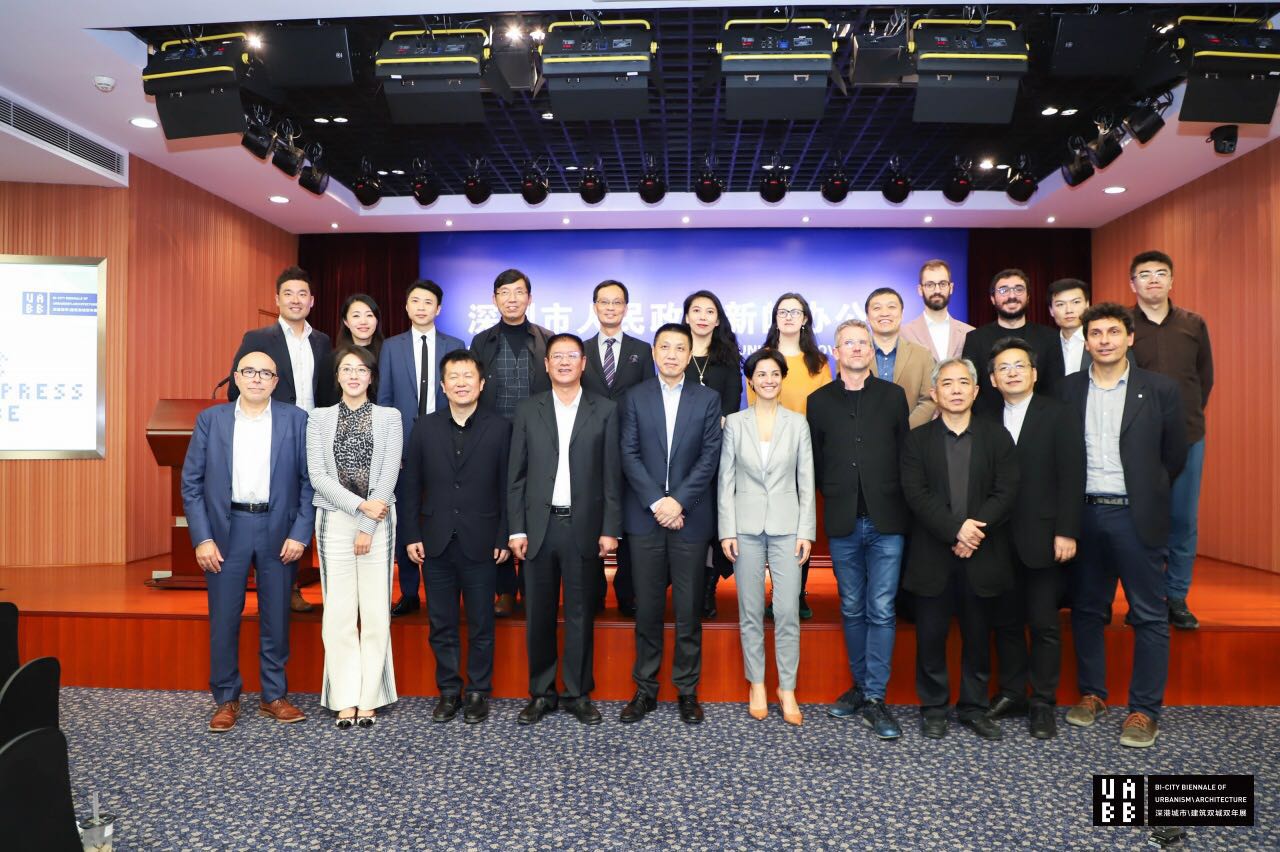Futian Station to serve as UABB main venue
Writer: Chen Xiaochun | Editor: Holly Wang | From: | Updated: 2019-04-02

Guests pose for a group photo at the first press conference of the 2019 Bi-City Biennale of UrbanismArchitecture (Shenzhen) (UABB (Shenzhen)) held at the Civic Center yesterday. Courtesy of the organizer
FUTIAN Railway Station and its surrounding area will serve as the main venue for the 2019 Bi-City Biennale of UrbanismArchitecture (Shenzhen) (UABB (Shenzhen)), according to a press conference held at the Civic Center yesterday.
“Choosing Futian Railway Station as the main venue is one of our key strategies. Firstly, it corresponds with the national strategy of Guangdong-Hong Kong-Macao Greater Bay Area,” said Zhang Yuxing, director of the UABB Academic Committee.
According to Zhang, Futian Railway Station is a connecting point linking Shenzhen, a key city of the Greater Bay Area, with Hong Kong, Guangzhou and Zhuhai. “This connecting point means our exhibition will connect with all the people in these cities.”
“The space this year is a bit different than the space in the previous biennales. In many previous biennales there was an old space to be transformed. Futian Station is actually a brand-new place that has been transformed,” said architect and director of MIT Senseable City Lab, Carlo Ratti, who is one of the three chief curators of the biennale.
However, Ratti and the team think the station has one problem. “It doesn’t have many connections. There are connections inside and escalators, but there are not many connections to link the taxi place and the park. Our proposal is to bring those connections, including a connection to the park with an elevator, paths and a vertical plaza, which will become a great way to advertise the biennale,” said Ratti.
Themed “Urban Interactions,” the biennale consists of two sections, namely “Eyes of the City” and “Ascending City,” which will explore the evolving relationship between urban space and technological innovation from different perspectives. The team of chief curators includes Ratti, CAE Academician Meng Jianmin and famous curator and art critic Fabio Cavallucci.
The “Eyes of the City” section is jointly curated by Ratti and the South China-Torino Lab, which was formed by South China University of Technology and Politecnico di Torino. It aims to investigate how artificial intelligence is going to impact architecture as well as people’s daily lives in the city.
The core exhibition of this section will include projects selected through an international open call targeting three groups of participants: architects, designers and artists; research centers and universities; writers, philosophers and scholars. The open call will last until May 31.
The “Ascending City” section is curated by a team headed by Meng and Cavallucci, bringing together a number of prestigious architects, artists, filmmakers, writers and museum advisers, as well as interdisciplinary professionals. Dimensional ascent and descent, which are concepts from science fiction, were adopted by the curatorial team as a very important methodology.
“Our section of the exhibition is ‘Ascending City.’ To me, an Italian who deals with the history of art, it immediately evokes a painting, ‘La citta che sale (the rising city).’ It’s a painting by the futurist artist Umberto Boccioni. It was created to represent the frenetic speed of the new city after the second industrial revolution, the electric revolution,” said Cavallucci.
Cavallucci said that we are now in the fourth industrial revolution — the automation revolution, which features the Internet of Things and artificial intelligence. “If we apply these technologies to a city, we will see a city that develops rapidly and runs quickly toward the future. This is a rising city. This is an ascending city for me.”
According to Xu Songming, vice secretary general of the Shenzhen Municipal Government, the UABB was initiated in 2005. It is the only international cultural event in the world that has set cities and urbanization as its long-term theme and is held every two years. It focuses on the urbanization of the cities in China and facilitates discussions on the problems that occur during urbanization through modern visual art.
The biennale, hosted by the Shenzhen Municipal Government and undertaken by Shenzhen Public Art Center, will run from this December to next March.
Apart from the main venue, so far the UABB has nailed down nine subvenues, including Bao’an International Art Design Center in Bao’an, Software Town of Shenzhen Universiade in Longgang and Dapeng Fortress in Dapeng New Area.